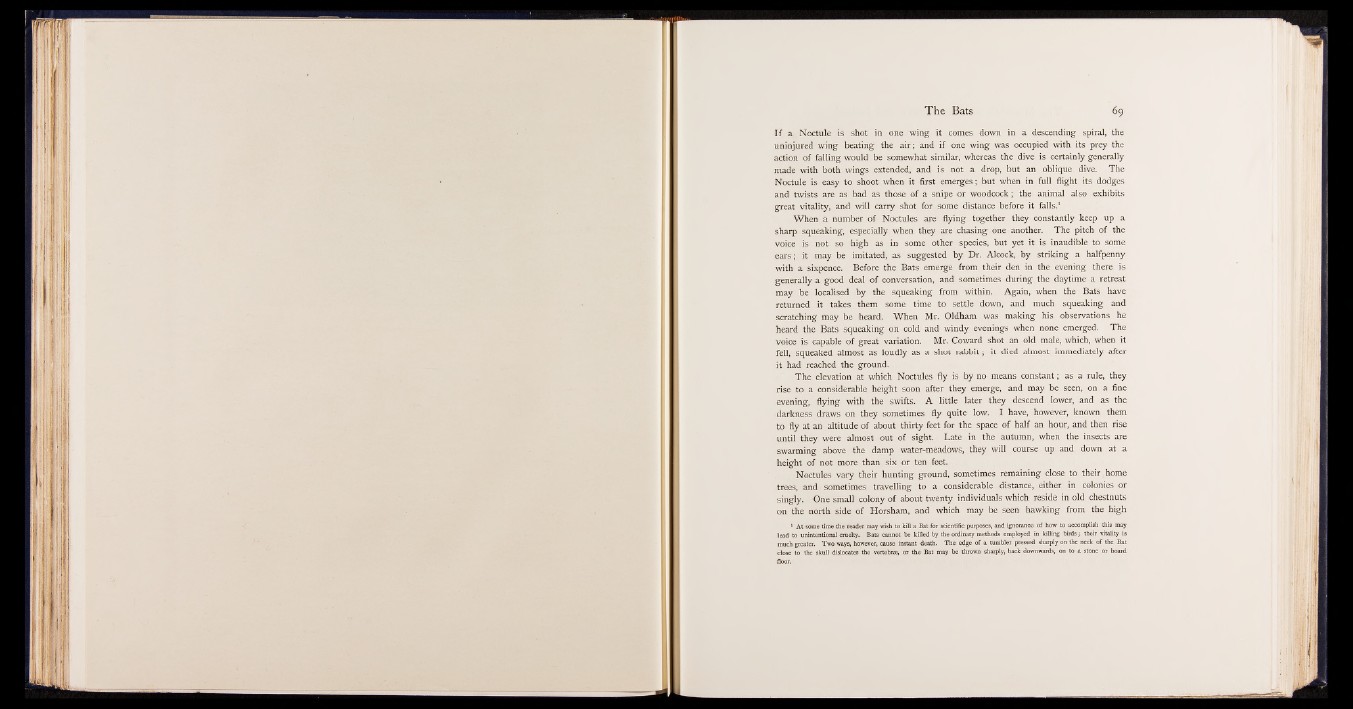
The Bats 69
I f a Noctule is shot in one wing it comes down in a descending spiral, the
uninjured wing beating the air; and if one wing was occupied with its prey the
action of falling would be somewhat similar, whereas the dive is certainly generally
made with both wings extended, and is not a drop, but an oblique dive. The
Noctule is easy to shoot when it first emerges; but when in full flight its dodges
and twists are as bad as those of a snipe or woodcock; the animal also exhibits
great vitality, and will carry shot for some distance before it falls.1
When a number of Noctules are flying together they constantly keep up a
sharp squeaking, especially when they are chasing one another. The pitch of the
voice is not so high as in some other species, but yet it is inaudible to some
ears; it may be imitated, as suggested by Dr. Alcock, by striking a halfpenny
with a sixpence. Before the Bats emerge from their den in the evening there is
generally a good deal of conversation, and sometimes during the daytime a retreat
may be localised by the squeaking from within. Again, when the Bats have
returned it takes them some time to settle down, and much squeaking and
scratching may be heard. When Mr. Oldham was making his observations he
heard the Bats squeaking on cold and windy evenings when none emerged. The
voice is capable of great variation. Mr. Coward shot an old male, which, when it
fell, squeaked almost as loudly as a shot rabbit; it died almost immediately after
it had reached the ground.
The elevation at which Noctules fly is by no means constant; as a rule, they
rise to a considerable height soon after they emerge, and may be seen, on a fine
evening, flying with the swifts. A little later they descend lower, and as the
darkness draws on they sometimes fly quite low. I have, however, known them
to fly at an altitude of about thirty feet for the space of half an hour, and then rise
until they were almost out of sight. Late in the autumn, when the insects are
swarming above the damp water-meadows, they will course up and down at a
height of not more than six or ten feet.
Noctules vary their hunting ground, sometimes remaining close to their,home
trees, and sometimes travelling to a considerable distance, either in colonies or
singly. One small colony of about twenty individuals which reside in old chestnuts
on the north side of Horsham, and which may be seen hawking from the high
> At some time the reader may wish to kill a Bat for scientific purposes, and ignorance of how to accomplish this may
lead to unintentional cruelty. Bats cannot be killed by the ordinary methods employed in killing birds; their vitality is
much greater. Two ways, however, cause instant death. The edge of a tumbler pressed sharply on the neck of the Bat
close to the skull dislocates the vertebrae, or the Bat may be thrown sharply, back downwards, on to a stone or board
floor.